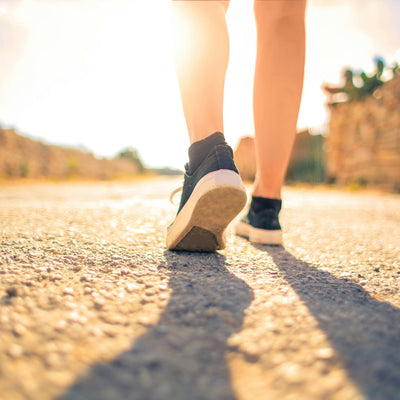Treating foot pain at home is easier than you think! Check out ten of the simplest home remedies below and let us know which worked best for you.
1. Hot and Cold Water Baths
Contrast baths are a form of hot and cold immersion therapy used to soothe sore muscles. The practice is known to reduce swelling, pain and encourage blood flow throughout the feet. Warm water causes vasodilation, which is followed by cold water that produces vasoconstriction. Alternating between both hot and cold baths pumps stagnant fluid out of the area, reducing inflammation. To begin, have a seat on the edge of your tub and allow warm water to flow freely over your feet for about 3 minutes. Next, switch the water to a cold temperature you can tolerate, and continue to allow the water to flow. Cycle between the two temperatures six times.2. Epsom Salt
Don't be confused—Epsom salt isn't for food. The name is derived specifically from the chemical structure of the substance. When exposed to water, Epsom salt breaks down into magnesium and sulfate. Adding Epsom salt to a warm bath will allow your body to soak in these chemicals, which work to reduce pain, swelling, and bruises. During an Epsom salt bath, make sure the water is very warm and add about one or two cups of salt. Leave your feet in the water for at least 12 minutes, and be sure to relax. Leave your feet in the water for at least 12 minutes, and be sure to relax.3. Ice
Ice therapy is one of the most useful home remedies for foot pain. Using ice can quickly reduce soreness, swelling and promote muscle health. Fill a bucket with water, then add ice. Dip your feet into the bucket and relax. Don't leave your feet in the ice bath for longer than 20 minutes. Perform several short treatments for the best results.4. Massages
Few things feel better than a good foot massage. Add in a little massage oil, and you're a little closer to heaven! If you want to try a massage to reduce foot pain, be sure to focus on trigger points. During the massage seek out tender spots in your feet and press on them, while gently stretching. These spots will feel like tight bands of tissue. Using oil for the massage will help encourage blood flow, stretch your muscles and increase flexibility.5. Fish Oil
Omega-3 oils are perfect for supporting nerve health and preventing foot pain. Adding a fish oil supplement to your daily routine, or simply introducing more seafood to your diet can improve the healing process and decrease inflammation. A recent study overseen by JM Kremmer revealed that patients who regularly consume fish oil decrease the intensity and frequency of pain. These patients also experienced less joint stiffness and inflammatory swelling in their joints. Fish oil can reduce the occurrences of foot pain and help feet feel more flexible.6. Workout Your Feet
The muscle groups of your feet make up about 25 percent of your body's muscles. It'd be insane to actively ignore the strength and function of such an important muscle group. Exercising the foot muscles helps to restore the length of the lower leg muscles, increases balance across the body and reduce foot pain. For one simple exercise, you can add to your morning routine you'll only need a towel. Drop a towel on the floor, and use your toes to scrunch the towel up towards your feet slowly. Repeat this motion about four to five times before you start your day.7. Kick Your Feet Up
Sometimes all you need is a little relaxation. Taking some time to elevate your fee will help reduce pressure throughout your legs. In most cases, elevating your legs feels pretty good immediately. The moment you lift your feet, blood is encouraged to flow within the veins of your legs. Maintaining an elevated position gives your feet a break for a few hours, and allows blood to move freely throughout the rest of the body.8. Stretching
When in doubt, stretch it out! Stretching is the easiest way to relieve tension and pain in the feet. After a long day on your feet, a good stretch can do wonders. We worked with Dr. Warner to create a list of the best stretches for plantar fasciitis pain relief. Each of these stretches targets the plantar fascia, delivering long-lasting relaxation. Click here to try out some the most helpful stretches for plantar fasciitis pain.9. Switch Out Your Shoes/Replace Worn Shoes
Unfortunately, it may be time to retire some of your favorite shoes. Older shoes provide an unstable environment for feet and forces abnormal movements. Footwear should always provide support, cushion, and be rigid enough to keep the feet balanced. It's healthy to replace your shoes every six months, especially workout shoes. If you're not sure if your shoes are worn out examine the sole tread pattern. If the pattern is worn down it may be time to chuck that pair.10. The Healing Sole: Relief at Home
Most shoes that promise to prevent pain and encourage recovery are uncomfortable, oddly shaped and unattractive. The Healing Sole creates an environment for recovery. The shoe is packed with six powerful features that work synergistically to heal the foot. The Healing Sole gently stretches the plantar fascia at the beginning of each step. As your foot pushes off, the rocker bottom sole sways to reduce tension. Once your foot meets the ground again, the compressible heel and raised arch absorb the weight of the body, reducing pressure at each pain point in the heel. Soft neoprene straps help to hold your foot in place as you move. The latest version of The Healing Sole is equipped with a durable outsole. Now our flip-flops last even longer and can support extended outdoor wear! For more information click here.












 Foot Health And Nutrition
Foot Health And Nutrition Effective Strategies for Managing Osteoporosis Foot Pain: Insights from Scientific Studies
Effective Strategies for Managing Osteoporosis Foot Pain: Insights from Scientific Studies